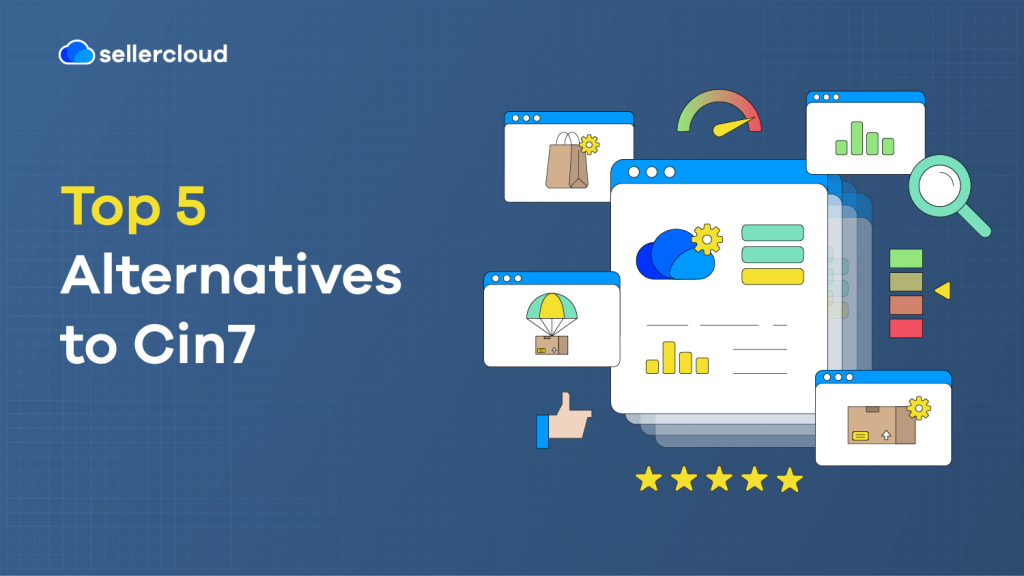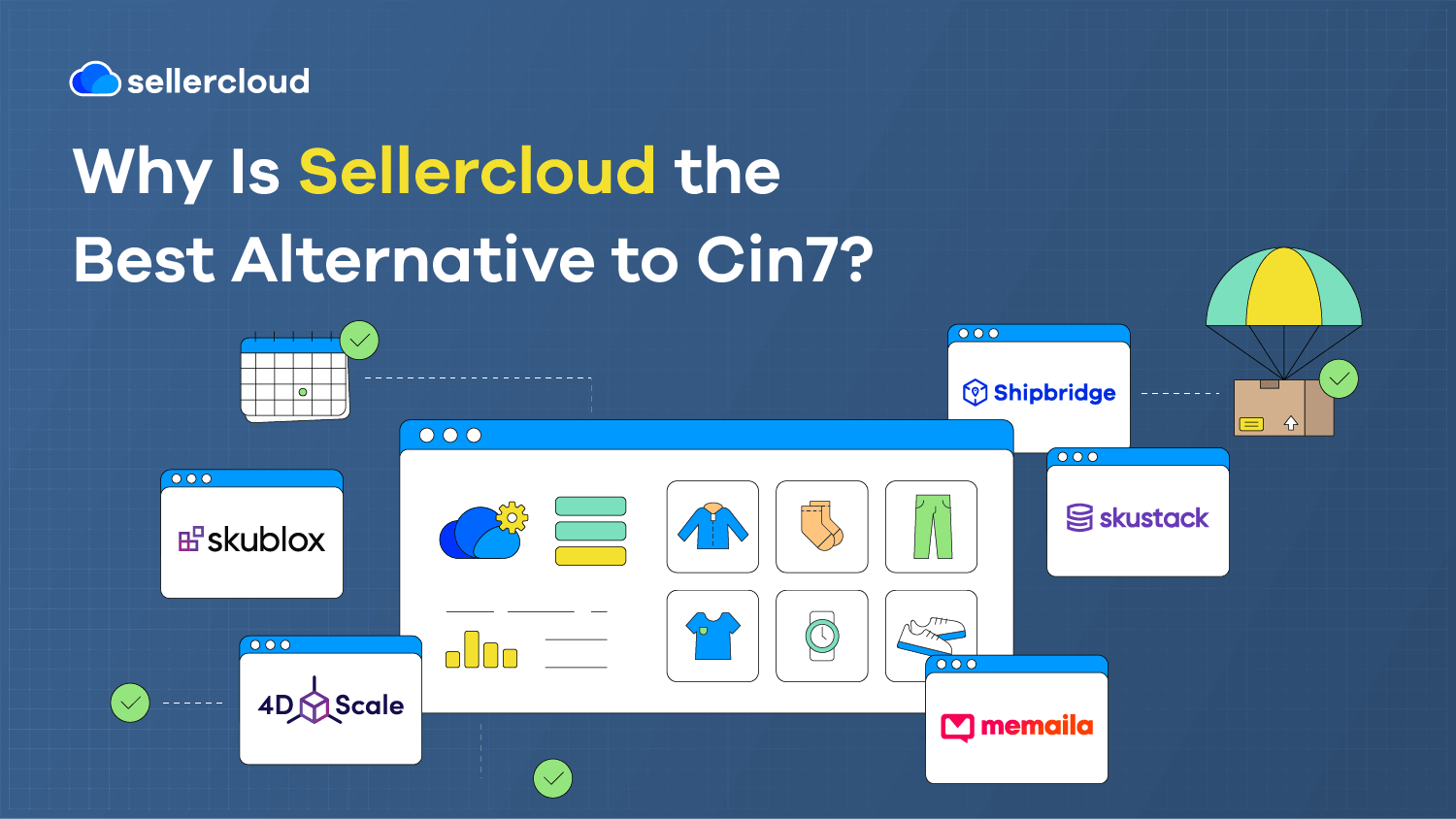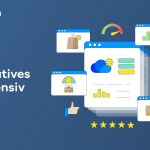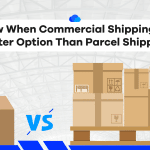
After a major investment by Rubicon Technology Partners in 2019, Cin7 expanded rapidly in the US.
Founded in 2012 and originating from Auckland, New Zealand, Cin7 has offices in Denver, Colorado, and around the world, including in Dubai, India, and Sri Lanka.
In 2021, Cin7 acquired DEAR Systems and Orderhive. DEAR Systems would become ‘Cin7 Core,’ Cin7’s cloud-based inventory and OMS (Order Management System) designed for small- to medium-sized businesses.
According to Cin7’s About Us page, the company handles over 125 million orders annually, has over 8,000 customers, and has a $35+ billion GMV (Gross Merchandise Value).
In this article, we’ll examine the best alternatives to Cin7, why ecommerce sellers look for alternatives to Cin7, and how to find the best alternative for your business.
What Are the Best Alternatives to Cin7?
Here are the top five alternatives to Cin7.
1. Sellercloud
The top alternative to Cin7, Sellercloud offers everything you currently get from Cin7 and much, much more.
Also, founded in 2012, Sellercloud is a privately held company based in New Jersey. It offers a catalog of features that suit any seller and a strong focus on customization.
Top Reasons to Consider Sellercloud:
- There are many shipping features, including Shipbridge, Sellercloud’s free shipping solution, the ability to create shipping rules, and support for high-volume shippers with commercial pricing.
- World-class in-house development team for customization to help customers build unique solutions, such as custom plugins and integrations.
- Automatic bundle creation and the ability to easily list the same product in multiple categories.
- Fills the gaps in Cin7’s Amazon offerings, such as enabling the consolidation of FBA shipments, Amazon Buy Shipping In Bulk, and blank box fulfillment.
- Patented tools include the Skustack WMS (Warehouse Management System) barcode scanning app.
- Certified ConnectShip and Amazon Software partner.
What Do Customers Have to Say about Sellercloud?
“It has a fairly simple and easy-to-use interface that allows me to do everything in a fairly quick and uncomplicated way, it also has metrics and statistics that are of great help to me when I want to make decisions that can impact the flow of income from My business, the fact that it has an inventory system is quite useful for me so as not to neglect the stock of my products, their customer service team is quite fast when answering any questions or problems that may arise during use of this application.”
– Michelle M., mid-market (51-1,000 employees).
For more about what Sellercloud customers say, check out Sellercloud’s Case studies and testimonials.
What’s Sellercloud’s Pricing?
Sellercloud prides itself on its pricing transparency. You can find out exactly how much Sellercloud would cost you by checking Sellercloud’s pricing page.
What’s also refreshing about Sellercloud’s pricing is that Sellercloud does not lock customers into multi-year contracts or require a revenue share, nor does it charge for integrations or implementation.
Sellercloud is confident enough in its service that customers will stay because it fulfills their needs without forcing them into a financial commitment.
In addition, Sellercloud does not increase its fee as your orders increase; in fact, the opposite is true; as your orders increase, Sellercloud’s fee decreases. Sellers should not be punished for doing well.
Furthermore, you can find out more about the pricing of Sellercloud products, such as Skustack, Skublox, and 4D Scale, on their websites.
Sellercloud is open about pricing from the get-go. Request a demo to see just how advanced Sellercloud is.
2. Shipedge
Founded in Durham, North Carolina, in 2017, Shipedge is an effective alternative to Cin7 if you need shipping features and customization.
Top Reasons to Consider Shipedge:
- Offers customization.
- Fairly comprehensive shipping features.
- Matches Cin7’s reporting capabilities and includes the ability to create custom reports.
Limitations of Shipedge:
- 135 integrations is a big step down from Cin7’s 700+.
- Shipedge cannot manage multi-channel listings.
- Multi-warehouse management is not available on Shipedge’s startup plan.
- Customization options are only available to enterprise-level users.
- Shipedge’s interface is not user-friendly.
- No email support. You must use Shipedge’s ticketing system.
- Does not offer Direct Fulfillment, nor can customers consolidate FBA shipments.
- Catalog features are lacking compared to Cin7. You cannot add dropshipping settings on a product level or import product information from multiple sources.
- Customers cannot manage product images or multi-channel listings with Shipedge either.
- Shipedge is a pricier alternative to Cin7, so it might not be a good choice if you want to lower your expenses.
What Do Customers Have to Say about Shipedge?
“The user interface is very simple, which I like. It has a lot of features that are above my pay grade, so if you’re discerning, Shipedge will likely live up to your expectations. However, if you’re like me and need something that you can teach to someone within 30 minutes and have them up and running, this is very good for that as well. Also, Shipedge’s service is great! I can pick up the phone and get someone knowledgeable within seconds.”
– Apparel & Fashion vendor, small business (50 or fewer employees).
What Is Shipedge’s Pricing?
While Shipedge could be a good alternative to Cin7, you must be aware of the significant costs associated with their solution before considering a switch.
Shipedge’s minimum starter contract starts at $840 monthly. However, Shipedge charges customers for a wide range of services, and these expenses quickly pile up.
For starters, Shipedge charges per SKU processed monthly, starting at $99 for 1,000 SKUs per month and increasing to $3,000 for 200,000 SKUs per month.
Shipedge also charges based on the number of integrations you use. Ten to 24 integrations cost $100; once you reach 25, it will be $200. This increases to $500 once you reach 100 integrations.
In addition, using Shipedge’s WMS will cost $390 monthly, OMS accounts will cost $20 monthly, and WMS devices will cost $15 monthly.
You will also incur monthly costs to use FBA, Shipstation, and per shipping carrier, and you will need to pay for 4PL, accounting, order routing, and many other expenses we haven’t listed.
To top it all off, you still must pay for implementation!
How Does Shipedge Compare to Cin7?
First and foremost, switching from Cin7 to Shipedge will give you many shipping features. While it offers fewer integrations than Cin7, it does offer customization, which could compensate for the missing integrations.
However, this is a risky trade-off. Before swapping Cin7 for Shipedge, you should ensure that you can customize Shipedge to get all the necessary features.
Another important consideration is the price difference. If you want to lower your operating costs, Shipedge is not a good alternative to Cin7.
Cin7 charges a minimum of $325 monthly, with a few other monthly additional costs for certain services. Meanwhile, with all the additional fees Shipedge charges on top of its $840 minimum, it will cost you an enormous amount each month.
See how Shipedge compares to Sellercloud.
3. Deposco
Founded in 2004 in Alpharetta, Georgia (just outside Atlanta), Deposco also offers shipping features you can’t get with Cin7. NewSpring and Aspen Capital Group invested in Deposco in 2021.
Top Reasons to Consider Deposco:
- Matches Cin7 in terms of inventory and Amazon features.
- Deposco integrates with all major US shipping carriers and consolidators.
- Offers a free shipping solution, single scan shipping functionality, and the ability to create shipping rules to automate and simplify shipping.
Limitations of Deposco:
- Deposco is a very expensive alternative to Cin7.
- Deposco doesn’t have 24/7 support. If you run into a problem outside of working hours, you’re on your own.
- WMS is widely known to be unuser-friendly and unpleasant to use.
- You won’t be able to create FBA shipments.
- Restocking module is a paid extra, and the price is not disclosed.
- Deposco is not transparent about the cost of its integrations, which could be an additional cost on top of what you are already paying.
- While Deposco has shipping features, you cannot set shipping preferences on a product level, and there is no support for high-volume shippers with commercial pricing.
- Deposco lacks many of the same Amazon features as Cin7, such as blank box fulfillment, consolidation of FBA shipments, and Amazon Buy Shipping In Bulk.
- Fewer purchasing options in comparison to Cin7, you will miss out on PO and RMA (Return Merchandise Authorization) receiving software at no extra cost and the ability to clone POs.
- Like Cin7, Depsoco doesn’t offer customization, so it isn’t the best option if you desperately need it.
What Do Customers Have to Say about Deposco?
“I like that the filtering tool it’s very friendly and easy to use, it helps me to find what I need quickly.”
– Food & Beverages vendor, mid-market (51-1,000 employees).
What Is Deposco’s Pricing?
Before even considering Deposco as an alternative, you must factor in their pricing, which is extremely high. In fact, Deposco is one of the most expensive alternatives on this list.
Businesses typically pay between $50,000 and $65,000 annually, with quotes based on business size. What makes this more problematic is that Deposco requires customers to sign a three-year contract, so if you switch to Deposco, you will be locked into that annual commitment.
Another Deposco expense that can quickly spiral out of control is the paid integration, which costs $200 per hour.
While this may not seem like much, the average implementation time is 700 hours. That means you could end up paying up to $140,000 before you’ve even started to use Deposco.
How Does Deposco Compare to Cin7?
Deposco offers fewer features than Cin7, though it does offer shipping, which is vital to most ecommerce businesses. It is also worth noting that Deposco offers more integrations than Shipedge, the previous alternative.
However, it will not make sense for many sellers to switch from Cin7 to Deposco solely because of its pricing.
While you will gain shipping features, you will lose many other Cin7 features you frequently use and must pay more than you already do.
It may be better for you to stick to Cin7 and combine it with a shipping solution or, ideally, find a solution that covers everything Cin7 offers and includes shipping.
See how Deposco compares to Sellercloud.
4. Goflow
Goflow was founded in 2014 and is based in New York City. While Goflow has some focus on customization, which Cin7 lacks, it falls short in some other areas.
Top Reasons to Consider Goflow:
- Though Goflow offers fewer features than Cin7, it does match them in many of the most crucial areas.
- Easily list the same product in multiple categories, which you cannot do with Cin7.
- Goflow is customizable and has some shipping features.
Limitations of Goflow:
- Very few WMS features. You may need to seek out an additional solution for warehouse management.
- You must make do without low stock and reorder alerts.
- Currently offers 115 integrations, which is considerably lower than Cin7.
- You cannot delete warehouses once you have created them.
- No mobile application, so Goflow has limited use on the warehouse floor.
- Goflow doesn’t allow users to perform bulk updates. This means you must do big updates manually, which is time-consuming.
- You cannot reserve inventory for specific marketplaces or deals with Goflow.
- Known not to offer the best reporting features, particularly regarding financial reports.
- While Goflow offers customization, it is limited and does not offer custom integrations.
- You cannot manage refunds and cancellations across all marketplaces with Goflow.
What Do Customers Have to Say about Goflow?
“The software for our ecommerce company is a comprehensive solution, covering everything from A to Z. Continuously expanding its features, and the support team is readily available through chat whenever we need assistance.”
– Joseph C., small business (50 or fewer employees).
What Is Goflow’s Pricing?
Goflow is affordable compared to other alternatives, such as Deposco and Shipedge, though it will cost more than Cin7.
With Goflow, orders start from $499 monthly for up to 2,500 orders to $3,900 monthly for up to 250,000 orders.
How Does Goflow Compare to Cin7?
Cin7 wins in terms of features. However, like Shipedge, Goflow offers customization and vital shipping features, so the trade-off isn’t exactly clear.
Additionally, while Goflow is more affordable than Shipedge and Deposco, it will still cost you more to use than Cin7.
Plus, dropping Cin7 for Goflow will mean losing much functionality, so you must compare the two thoroughly before committing any change.
See how Goflow compares to Sellercloud.
5. Zentail
Founded in 2012 in Baltimore, Maryland, Zentail has seven investors, including technology startup accelerator Y Combinator. Depending on your needs, Zentail could be worth exploring.
Top Reasons to Consider Zentail:
- Custom reporting and matches most of Cin7’s reporting features
- Includes a free shipping solution, and you can set shipping preferences on a product level.
- Matches most of Cin7’s listing features.
Limitations of Zentail:
- Zentail uses Skuvault (recently acquired by Linnworks) for their WMS.
- Does not offer customization.
- Does not work with POs.
- No FBA.
- Limited number of integrations—around 50.
- Much of Zentail’s functionality focuses on product listings and less on other vital ecommerce operations.
- Very limited inventory management features.
- No purchasing options whatsoever.
- Practically no warehouse features other than the ability to track inventory in and out of warehouses.
- No 24/7 support or email support, which is something that Cin7 does offer.
What Do Customers Have to Say about Zentail?
“I love how user-friendly the interface of the software is, and that there is always available support through chat or help articles. I also really appreciate that the team at Zentail listens to any suggestions and truly takes the feedback into consideration. I feel very supported through using the system, and know that I will have a knowledgeable team behind me if I need assistance.”
– Kira S., small business (50 or fewer employers).
What Is Zentail’s Pricing?
Zentail charges a total annual fee of $12,000 ($1,000 monthly), and you must pay an implementation fee of $2,500.
Zentail also charges a base fee of $4,500 for Amazon orders, which covers a GMV (Gross Merchandise Volume) of $2,000,000. Once your Amazon orders pass this GMV, the fee rises to $7,500.
Meanwhile, when you reach a GMV of $500,000 from other marketplaces (outside of Amazon), your off-Amazon GMV tier fee increases by $7,500. Essentially, every $500,000 of additional revenue growth costs $7,500 annually.
Zentail also has an SKU limit of 10,000. If you exceed this, you must pay $0,08 per SKU.
How Does Zentail Compare to Cin7?
Zentail is not a perfect alternative, but it is still one you should know about. You could see it as an alternative if you want to simplify your operations.
It is an out-of-the-box solution without customization options and minor shipping features.
In this sense, Zentail could be called a good ‘scaling down.’ However, the costs associated with Zentail are high. While it is an alternative, it is probably not the best.
See how Zentail compares to Sellercloud.
Why Do Businesses Search for Alternatives to Cin7?

There are plenty of reasons businesses search for an alternative to Cin7. It doesn’t have to be a catalog of reasons. It could just be that Cin7 is missing one or two features they desperately need to operate.
Businesses look for alternatives to Cin7 mainly because it doesn’t offer shipping software. For many ecommerce sellers, this is an absolute must-have feature.
For many sellers, shipping software is the most important thing a solution like Cin7 should offer—more than listing features and inventory and warehouse management.
Sellers need to ship their products to customers, after all. It’s integral for the success of an ecommerce business.
Another deal-breaker could be the absence of particular Amazon features. Cin7 doesn’t offer the ability to create FBA inbound shipments or automatic inventory deductions for FBA transfers via Seller Central.
Many sellers rely on Amazon sales, and not having these features is inconvenient.
Elsewhere, it might just be that ecommerce sellers can’t get all the services they need on Cin7. Though Cin7 has over 700 integrations, there’s always the chance that they can’t connect something they depend on daily.
On top of that, of the integrations that Cin7 offers, sellers must request that they be enabled before they can be configured. It’s not as simple as just plugging in the integration, and it works. Furthermore, many of these integrations require a monthly fee.
Lastly, if you need to customize anything in Cin7 to better meet your needs, you’re out of luck. Customization is completely off the table with Cin7. It is a solely ‘out-of-the-box’ solution.
How to Choose the Best Alternative to Cin7?
Cin7 is robust in many ways and can meet almost all ecommerce needs. However, its service has significant shortcomings, which cause sellers to look for an alternative.
As mentioned above, you might look for an alternative because it lacks shipping software. However, just because a service offers good shipping software doesn’t mean it’s a perfect solution for your business. It may be lacking in other areas where you depend on Cin7.
Similarly, if you need FBA and other important Amazon services, look for a solution that integrates with those services without sacrificing key features you rely on Cin7.
Ultimately, you’ll want to find a solution that provides you with everything Cin7 offers and more. There’s no point trading one problem for another.
So, consider this when assessing your business needs and the options before switching to an alternative.
This is why you should always get a demo to fully understand the potential pitfalls of the features of the available alternatives and how they work technically.
Another important thing to do is check reviews.
Reviews can be a rich source of user information. They allow you to see what customers loved most about the solution, what issues users typically encounter, and whether they were ever resolved.
However, read reviews with a pinch of salt. Sometimes, reviews may exaggerate issues or are fake, unverified, or paid reviews to promote or smear a solution.
Lastly, remember to factor in the costs. Most alternatives are more expensive than Cin7, so you must ensure you get more value from the change.
Why Is Sellercloud the Best Alternative to Cin7?

When comparing alternatives to Cin7, Sellercloud is the best all-encompassing service. It’s a real all-in-one solution for the modern ecommerce landscape.
Sellercloud’s devotion to customization is an enormous advantage. You can transform Sellercloud into the solution you need for your ecommerce business and easily bring over any services you use on Cin7.
Of the alternatives, Sellercloud has the widest range of shipping features. Moving from Cin7 to Sellercloud, you can finally bring your shipping operations under the same centralized interface as the rest of your ecommerce business.
This makes things significantly easier and provides a single source of truth for tracking your orders. And that’s before even mentioning that Sellercloud includes free shipping software.
Sellercloud also offers all the reporting features you rely on from Cin7, as well as a greater number of Amazon, purchasing, warehouse, and catalog features.
While Shipedge, Deposco, and Zentail have their benefits, Sellercloud tops the list because it builds on top of what Cin7 already offers.
In addition to shipping and customization, Sellercloud users have access to Amazon blank box fulfillment, consolidation of FBA shipments, and Amazon Buy Shipping In Bulk, useful Amazon features Cin7 does not offer.
Key Points
You now have several great options to replace Cin7. Remember these key points.
- Cin7 was founded in 2012 and offers many integrations. In 2019, Rubicon Technology Partners invested in Cin7, enabling it to expand in the US and acquire other companies.
- The best alternatives to Cin7 are Sellercloud, Shipedge, Deposco, Goflow, and Zentail.
- People look for alternatives to Cin7 because it lacks shipping, customization, and certain FBA features.
- When looking for alternatives to Cin7, you must thoroughly consider the trade-off between features and potential cost increases.
- Sellercloud is the best alternative to Cin7 because it offers everything Cin7 offers and more. Most crucially, customization and a wealth of shipping features.
Cin7 FAQs
Is Cin7 an ERP?
No, Cin7 is not an ERP (Enterprise Resource Planning) software; it is an OMS (Order Management System). This means its primary customers are not manufacturers but rather ecommerce sellers.
How Old Is Cin7?
Cin7 was founded in 2012, so as of 2024, the company has been around for 12 years.
Who Bought Cin7?
In October 2019, Rubicon Technology Partners acquired a majority stake in Cin7. This investment is mainly responsible for Cin7’s expansion across the US and its acquisition of DEAR Systems and Orderhive two years later.
Rubicon Technology Partners is the only investor in Cin7.




